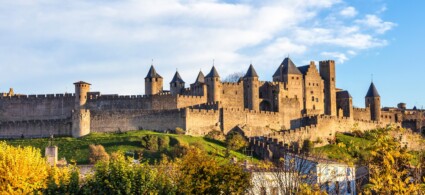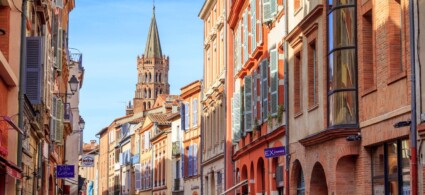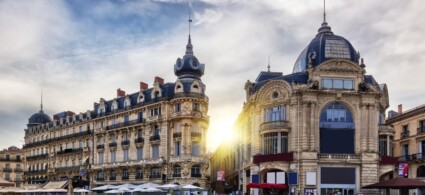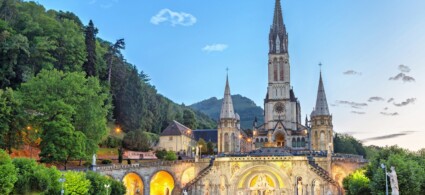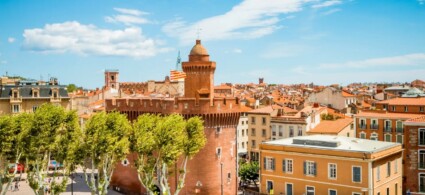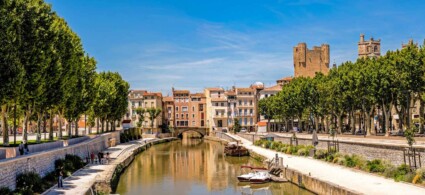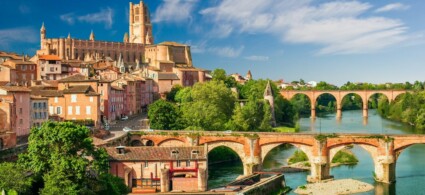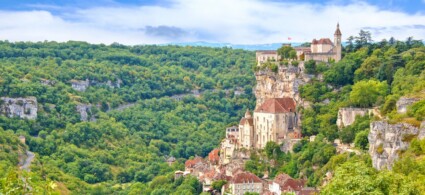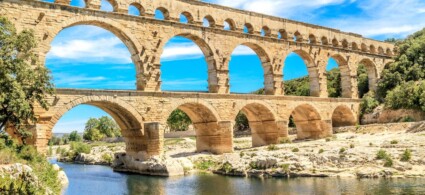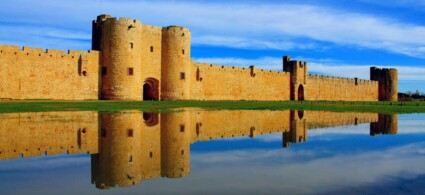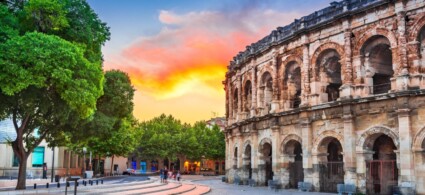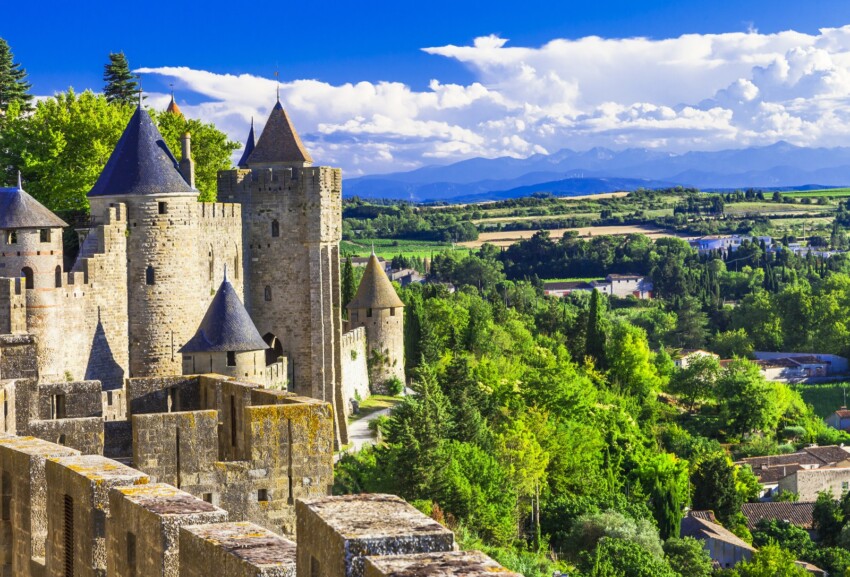

Occitania, after the administrative reform of 2016, is the region that brings together the pre-existing regions of Languedoc-Roussillon and Midi-Pyrénées.
This corner of France is particularly rich in history and culture: it is the land of the langue d’Oc, the southern French dialect, which has preserved many aspects of the ancient Romanesque language.
Nestled between the Mediterranean Sea and the Pyrenees mountains, Occitania is an extraordinary land that is as little known to mass tourism as it is to the general public. It is home to deep canyons, enchanting medieval castles, perched villages, towns rich in history and art, and a fascinating wilderness.
The Occitanie region in France is made up of 13 departments that bring together countless tourist attractions. In addition to its 220 km of coastline along the Mediterranean, the area boasts the Canal du Midi, which connects Toulouse to the sea, the mountainous landscapes of the Pyrenees and the Massif Central, the countryside, a rich cultural heritage, UNESCO heritage sites and lively cities such as Montpellier and Toulouse.

The most precious and famous jewel of Occitania is undoubtedly Carcassonne: Euroapa’s best-preserved fortified citadel enchants visitors with its 3-km-long concentric double walls, 52 towers and four gates.
An absolute marvel that has remained miraculously intact, which will take you back in time to the Middle Ages, knights and ladies.

Toulouse is the capital of Occitania: welcoming and sunny, the city embraces visitors in its orange-brick setting, shaped by years of history. Its relaxed and convivial atmosphere makes it one of the cities where many French people dream of moving to.
In this joyous city, grand Romanesque and Gothic buildings such as the Saint-Sernin Basilica, the Hôtel-Dieu Saint-Jacques and the Jacobin convent, coexist with places dedicated to aeronautical and space culture.

Occitania is a diverse land steeped in culture. This is demonstrated by its ancient and lively cities of art such as Perpignan, which still retains its Catalan soul: the Palace of the Kings of Majorca, a Gothic-style fortress, dominates the medieval heart of the city.
At the top of the Tribute Tower, one can admire the view of the Roussillon plain, the Canigó, the Albères massif and the Mediterranean.

Dynamic, creative and attractive, Montpellier is a city that surprisingly combines an ancient urban heritage with contemporary architecture, moving harmoniously from medieval streets to modern districts.
Port Marianne, for example, is a new generation area, designed by the great names in contemporary architecture around the Jacques Cœur reservoir.

An imposing bishop’s town on the UNESCO World Heritage list, Albi is home to an enormous red-brick episcopal complex that includes the Sainte-Cécile cathedral, a masterpiece of southern Gothic art, the collegiate church of Saint-Salvi and its cloister.
But Albi is also the birthplace of the great painter Toulouse-Lautrec, to whom a wonderful museum is dedicated, with a very rich collection of posters, paintings, drawings and lithographs.

The city of Nimes is famous for its Roman amphitheatre dating back to 70 AD, one of the best preserved ancient monuments in Europe. It still hosts important events such as the Féria, many historical shows and the Nimes Festival.
Also, walking up Boulevard Victor Hugo, you can admire the Maison Carrée, one of the few Roman temples in the ancient world to be entirely preserved.

Just 35 minutes north-east of Nîmes is an absolute wonder of the Roman world, Pont du Gard. It is the only three-storey aqueduct that still exists in a perfect state of preservation. 275 metres long and 49 metres high, this impressive work from the Roman period was classified as a UNESCO monument in 1985.

Narbonne was one of the richest Roman colonies outside Italy and today preserves a real treasure: a piece of the Via Domitia in the city centre. Don’t miss Narbo Via, the museum dedicated to the origins of the city, which boasts a rich collection of almost 10,000 pieces, with an exhibition space of 2,600 square metres.
The view from Gilles Aycelin’s keep, the Saint-Martial tower, the Gothic cathedral of Saint-Just and Saint-Pasteur with its cloister and the Archbishops’ Palace is also fabulous.

At the foot of the Pyrenees, the town of Lourdes has become one of the largest pilgrimage sites in the world, following the apparitions of the Virgin Mary to Bernadette Soubirous in 1858.
Millions of pilgrims come from all over the world to pray at the Sanctuary of Our Lady of Lourdes and to visit the three balisques of the religious complex.

Once the first port of the kingdom of France on the Mediterranean, today Aigues-Mortes is no longer on the sea and is surrounded by salt marshes. This marvellous fortified citadel retains a tour of monumental ramparts, 1.6 km long, which can be walked the whole way.
Aigues Mortes is located at the gateway to the Camargue and shares its unmistakable wild landscape, gypsy culture and herds of bulls and horses.

Built by Pierre-Paul Riquet, Louis XIV’s tax collector, the Canal du Midi is an artificial canal stretching from Sète to Toulouse. Connected to the Canal de la Garonne, it was part of a grandiose and ambitious project: to allow commercial barges to sail from the Mediterranean to the Atlantic.
240 kilometres long, the canal has 103 locks to overcome a total height difference of 190 metres and is still navigable today. It is possible to travel along it on organised small cruises or rent a boat to follow its course independently and admire the gentle landscapes that surround it, while also visiting the small villages along its route.

The end point of the Canal de Midi, Sète is characterised by picturesque canals lined with colourful facades and crossed by drawbridges and swing bridges.
Its ports, both commercial and tourist, teem with life with the hustle and bustle of trawlers and the colours of Catalan boats, while the authentic fishermen’s quarter, Pointe Courte, and the Quartier Haut, where you can breathe in the atmosphere of southern Italy, are unmissable stops in the city.

25 km from Albi is one of the oldest bastides of Occitania, the perched and often fortified medieval towns.
Founded in 1222 by Raymond IV, Count of Toulouse, perched on a rocky ridge of the Puech de Mordagne, Cordes sur Ciel preserves a colourful medieval atmosphere, which has remained intact thanks to the rich Gothic façades of its buildings, the luxurious Gothic-style residences of wealthy merchants, the artisans’ workshops and the medieval festivals.
Other bastides, equally enchanting, should also be visited, such as Puycelsi, a fortified town, ranked in the list of France’s Most Beautiful Villages, Castelnau-de-Montmiral, the castles of Bruniquel, Caylus, a pretty medieval village with beautiful residences including the famous Maison du Loup or Mirepoix, a medieval village with colourful half-timbered houses.

The Pyrenees National Park is a jewel of Occitania’s natural heritage, inscribed on the UNESCO list: sharp peaks exceeding 3000 metres, waterfalls, streams and sparkling lakes await you. Here you will find some of the most beautiful landscapes in France and a wide variety of mountain animals such as the isard, an emblematic species of the Pyrenees.
With its unspoilt nature, it is a paradise for mountain hikers, who will not miss the opportunity to explore the trails around Mont Canigó, the most famous peak in the Eastern Pyrenees, at 2784 metres high.
To admire the most spectacular panorama in the whole of Occitania, you will have to climb to the Pic du Midi, the balcony of the Pyrenees: the cable car will take you in 15 minutes to an altitude of 2877 metres with a 1,000-metre difference in altitude.
Famous for housing the world’s oldest high-altitude astronomical observatory, this vantage point offers a view formed by 300 kilometres of mountains in front of you. On a clear day, you can even see the first spurs of the French Massif Central.

Also in the Pyrenees National Park is the Cirque de Gavarnie, carved 50 million years ago by glacial erosion.
From the village of Gavarnie, an easy 1-hour walk will take you to the foot of this incredible 1,700-metre-high rock face with a circumference of 14 km, made up of concentric levels of astonishing symmetry and surrounded by numerous peaks over 3,000 metres high.

Born in Mont Lozère, the Tarn river flows along the Cévennes chain in a torrential stream that, over the centuries, has carved a very deep canyon in the plate of the Grands Causses.
The gorges are formed by cliffs up to 500 metres high, with breccias, ledges and rocks, offering visitors a remarkable natural spectacle, especially in the stretch between Quézac and Le Rozier, for about 50 km. They can be explored by car, on foot or by canoe and are dotted with picturesque villages such as Sainte-Enimie.

The mountains of Occitania have for centuries been guarded and guarded by marvellous castles, imposing and massive like that of Foix17, which dominates the landscape from the top of its rock, with its walls, towers and battlements intact. Nestling at its foot, the town has retained its period charm and from May to October offers festivals and medieval days.
Rocamadour18 is a kind of vertical village, built in several stages on the side of a cliff and clinging 150 metres above the Alzou canyon. Houses, castle, roofs and churches seem to be part of the rock.
The ruins of the castle of Montségur Castle19 can be reached on foot, perched at an altitude of 1,200 m: from here there is an extraordinary view of the Pyrenees. They were the last refuge of the Cathars persecuted by the Church.
In Occitania there are many ruined manors, also called the citadels of vertigo, because they offer breathtaking views from the top of the rocky spurs they cling to. These are the Cathar castles: Lastours, Quéribus, Peyrepertuse, Puilaurens, Termes, Aguilar, to name but a few.
In the following map you can see the location of the main places of interest mentioned in this article.

Occitania is known throughout the world for being the birthplace of one of the most famous artists of the Belle Epoque . The son of inbreds, Toulouse-Lautrec was born on 24 November 1864 in Albi to a wealthy family, suffering from a kind of dwarfism, probably caused by a severe form of brittle bone, which impaired the development of his lower limbs.
With a sanguine and surly character, despite the family comforts, the painter preferred to embrace the bohemian life of nocturnal Paris among absinthe, prostitutes and derelicts, becoming the most desecrating portraitist of the Ville Lumiere. In fact, Toulouse-Lautrec, who settled in Montmartre, chose not to immortalise damsels in crinolines and wealthy aristocrats but clients and prostitutes, nocturnal bacchanals, dancers, shabby clubs and brothels, annoying the public with his gaze devoid of moral judgement and sweetened filters.
In Albi, his hometown, the Toulouse-Lautrec Museum celebrates the figure of one of the most irreverent and controversial artists in history through more than 1,000 works, the world’s largest collection of Lautrec.
Every corner of the city speaks of Toulouse-Lautrec, with phrases and memories of the painter scattered through the streets and on shop windows, reproductions of the paintings on display in the city, reminding us of the great and misunderstood figure of a unique artist.

Occitania, and Toulouse in particular, are the cradles of French gastronomy: the local cuisine combines strong and contrasting flavours such as the nutty taste of a good foie gras with the surprisingly delicate notes of Mediterranean oysters or the unmistakable flavour of truffles, all paired with fuller-bodied cheeses such as the savoury Roquefort, with its strong, decisive smell, and the goat cheese Rocamadour.
And from the table to the markets, the step is short: try a bottle of Armagnac, Foix sausages, Nîmes olives, Pyrenean artichokes, pink garlic from the Tarn-et-Garonne area.
But the great star of Occitan cuisine is Cassoulet, a stew made with pork, duck and sausage, enriched with white beans and cooked for hours in an earthenware casserole, from which it takes its name.
By plane, the nearest airports to reach Occitania are Toulouse Airport and Bordeaux Airport or, although a little further away, Marseille Airport and Lyon Airport.
Occitania can also be reached by train, on the Paris/Bordeaux/Montpellier/Barcelona axis. In addition to regional routes, it is also crossed by 2 high-speed lines: the line from Perpignan to Figueras in Spain, and the LGV Méditerranée.
